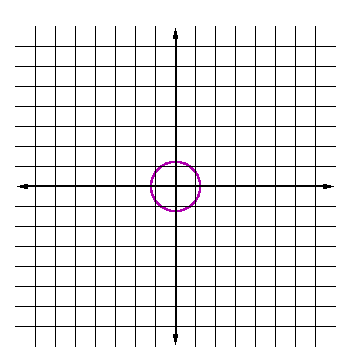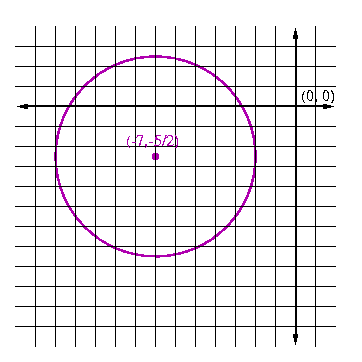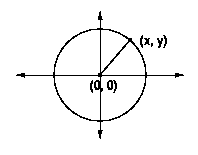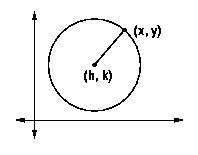- Identify the centre and radius of the circle defined by:
a) x2 + y2 = 1 centre (0, 0) radius 1 b) (x - 3)2 + (y + 4)2 = 24 centre (3, -4) radius Ö24 c) x2 + (y - 7)2 = 121 centre (0, 7) radius 11
- A circle centred at the origin has a radius of
(Ö5)/ 2. = 1.12 (approximately)
| a) Sketch the graph of this circle on the graph paper provided. |  |
| b) Write the equation of this circle in standard form. | |
| c) Write the equation of this circle in general form. |
| a) Sketch the graph of this circle on the graph paper provided. |  |
| b) Write the equation of this circle in standard form. | |
| c) Write the equation of this circle in general form. | or |
| Variable | The value of the variable decreases | The value of the variable increases | The value of the variable is 0. |
|---|---|---|---|
| circle shifts left |
circle shifts right |
circle is centred somewhere along the y-axis | |
| circle shifts down |
circle shifts up |
circle is centred somewhere along the x-axis | |
| circle gets smaller | circle gets larger | result is a point |
a) Determine the centre and radius of this circle.
| Centre: | Radius: 7 |
b) Sketch a picture of the circle on the provided graph paper.

If A, B and C all lie on the same circle centred at the origin, then the distances from each of A, B and C to the origin must be equal.
A must equal B
Describe what happens to the circle as the horizontal plane:
| a) moves closer to the vertex the circle gets smaller | 
|
| b) moves away from the vertex the circle gets bigger | |
| c) cuts the double-napped cone at the vertex the result is a point |

a) What is the radius of this circle? Radius = 6
b) Write the standard equation of this circle.
c) If the radius of the circle remains constant, then what would be the standard equation of the circle centred at the point
d) Sketch the translated circle in the above graph.
e) Explain how the circle was translated.
The circle was translated right 4 units and down 6 units
a) Show that these two equations are equivalent.
Let's expand the first equation:
==>
==>
b) When two equations are equivalent they have identical solution sets. Verify that the point
Substitute
= -52 + 122 = 25 + 144 = 169 |
= 81 + 36 - 72 + 72 - 117 = 0 |
In the form
Show how these two statements are saying the same thing.
a) Derive the standard equation of a circle centred at
 |
Let r be the radius of this circle. Therefore r is the distance between the point Applying the distance formula yields the equation Squaring both sides yields the standard equation we are looking for, |
b) Derive the standard equation of a circle centred at
 |
Let r be the radius of this circle. Therefore, r is the distance between the point Squaring both sides yeilds the standard equation for circles centred at |